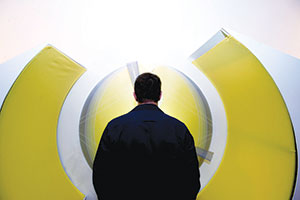
Dream State is one of many fascinating works of art on display at the Nave Gallery’s Fresh Media exhibition, now through April 11.
By Jack Adams
Fresh Media held its opening reception at the Nave Gallery in Somerville this past Friday. Fresh Media is an exhibition of interactive works put on by the Dynamic Media Institute, which is comprised of graduate students at the Massachusetts College of Art and Design. The exhibit will stay open through April 11.
Fresh Media’s website describes itself as “a unique prototyping event presented in a gallery environment. We use this opportunity to conduct user-testing and to think beyond the classroom.”
Most of the pieces on display were interactive. Artist Sofie Elena Hodara’s piece, called “IHear,” requires the viewer to put on headphones and move their hand above a small black box.
“[IHear] is a little box that plays music. The idea is that as you put on the headphones, you can interact with the sounds, and you manipulate them,” Hodara said.
The IHear has four light sensors, each one connected to a different recording of a cellphone ringtone. As you move your hand closer, the ringtones get faster.
“The idea is that by manipulating these ringtones, the piece is sort of asking its user to reconsider the relationship they have with their devices,” Hodara said. “It’s really fun to play with, that’s the main point. You play and then, through sort of this playful process, you hear these things as ringtones.”
To make the piece, Hodara used computing hardware called Arduino and free software called Pure Data. She mapped the light sensors to the ringtones, as well as four LED lights, to show which ringtones were activated.
“It’s taken me a while; it’s a little bit of math,” she said. “I think what was hard for me was learning how to program, how to use the programming tool in the way that I needed to.”
Artist Phil Gedarovich took a slightly different approach with his piece, called “Brain Drain.”
“The idea behind the Brain Drain is that it’s sort of an educational piece, where you interact with parts of the brain and then learn about the functions of that area,” Gedarovich said.
In addition to being a student and an artist, Gedarovich also helped curate the exhibit. He said the Fresh Media show is a prototype exhibition and a way for the students involved to get feedback on their pieces.
The Brain Drain is supposed to teach viewers about their own brains and how the different parts function. It consists of a malleable plastic brain on a table with a screen in front of it. When the viewer pushes on a particular part of the brain, information about that part comes up on the screen.
“The idea with this is that it involves touch and tactile qualities to help encourage remembering of things. You touch a part of the brain, and then it presents information about that particular structure of the brain,” Gedarovich said.
Although in the Nave Gallery the brain was on a table with all of the other art, Gedarovich said he would prefer if the piece were by itself in a dark room, where the viewer would have to sit and also wear the brain on their head. He said he wants the whole experience to feel as if you were about to be brainwashed.
“I’m trying to design unexpected experiences,” he said. “I’m sort of calling it subversive, with a question mark, design. It’s sort of a creepy or strange thing that you wouldn’t want to touch, but then it ends up being beneficial.”
A piece called “Germ’d” requires the viewers to draw their own germs, which then appear floating around on a large screen.
“The idea is it’s a PSA, but the “P” stands for “participatory,” to raise people’s awareness about germs by drawing their own versions and having them hang out,” artist Fish McGill said. “By engaging with it, it gets you to think about germs in a deeper way.”
McGill said that although the Javascript he needed to code the piece was difficult to learn, having a concept of what he wanted to make helped him.
“[Javascript is] difficult, but once you have an idea of what you want to do, you find the people that know certain things,” he said. “It’s like saying, ‘Today we’re going to make baking soda; today we’re going to make flour instead of having an actual recipe. I’m going to make a pie; what are we going to need for that?’ Rather than ingredients-based learning, this is recipe-based learning.”
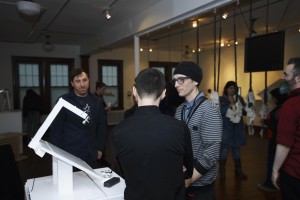
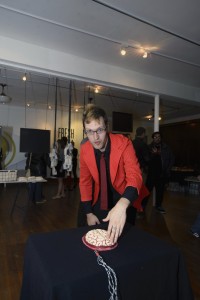
Phil Gedarovich and ‘Brain Drain’
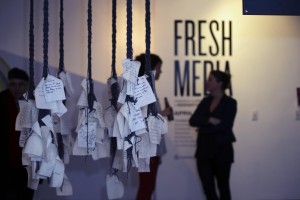
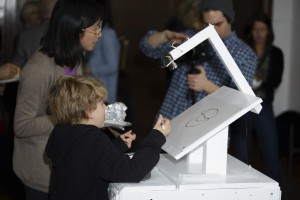
‘Germ’d’
— Photos by Jack Adams















Reader Comments